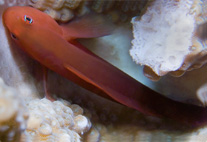Abstract
Four new species of the coral-associated gobiid genus Gobiodon were discovered in the Red Sea. Although several of these species are common not only in the Red Sea but also in the Indian and western Pacific Ocean, they have not been described before. Detailed descriptions of the four species are based on morphological and molecular genetic (mitochondrial 12s and 16s rRNA) investigations. The new species, like most species of the genus, lack scales and have species-specific life colouration. Gobiodon bilineatus sp. nov. is the closest relative to G. quinquestrigatus (Valenciennes) and of G. sp. D (Munday et al.), and has five distinct, blue lines on the head as juveniles and subadults, which disappear in adults, and which are often uniformly orange-red with two distinct, vertical blue lines through each eye. Gobiodon irregularis sp. nov. has been confused with the former new species in the past, and is closely related to G. oculolineatus Wu, but is unmistakable in live colouration. Juveniles are characterised by a transparent body, red bars on the head with bluish to greyish interspaces, and irregular red lines and dots on the nape and dorsally on the body. Adults are usually uniformly brown or green-brown, with only remnants of the bars through the eye and below the orbit. Gobiodon ater sp. nov. is a small, entirely black species and can be easily confused with other black species, although it is genetically clearly distinct from G. ceramensis Bleeker and its black relatives. Gobiodon fuscoruber sp. nov. is likely to be the closest relative of G. ater sp. nov., but is uniformly reddish-brown or brown, has bright median fin margins (at least in the Red Sea), and grows considerably larger than G. ater. It has been genetically determined that G. fuscoruber sp. nov. is identical with an Indian Ocean/western Pacific species that has been called G. unicolor Castelnau by several authors. However, examination of the holotype of G. unicolor, including the original description, revealed that the type species and original description are clearly different from the species frequently called G. unicolor. The holotype resembles G. histrio (Valenciennes) and the name G. unicolor must therefore be considered a junior synonym of G. histrio. As a consequence, a new name for this species is provided.

